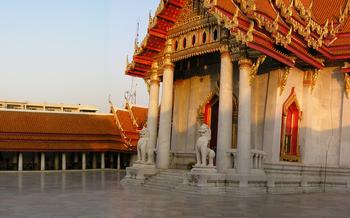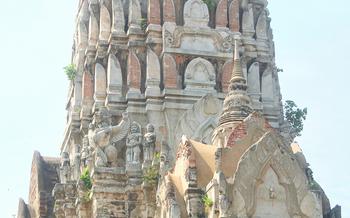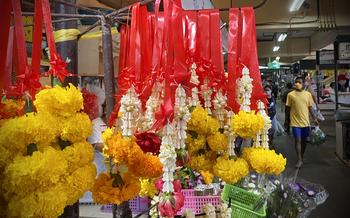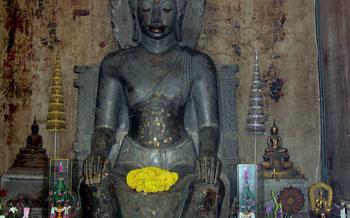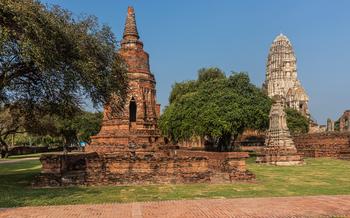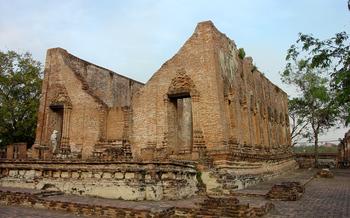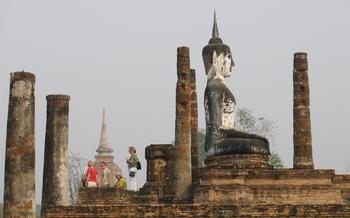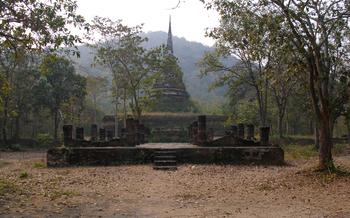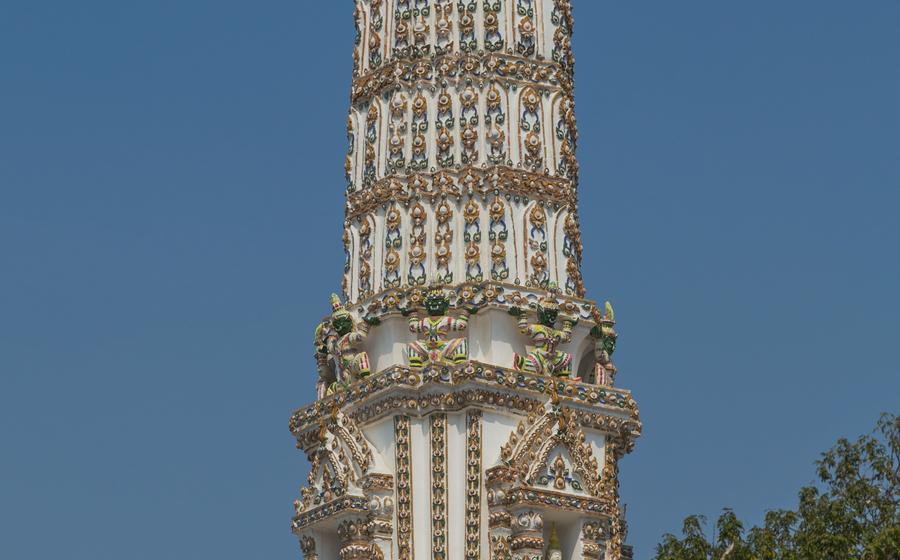
Wat Thepthidaram
- Exploring the Temple Grounds
- The Grand Ubosot (Main Prayer Hall)
- The Stupas (Chedis)
- The Buddha Images
- The Temple's History and Legends
- The Temple's Cultural Significance
- Tips for Visiting Wat Thepthidaram
- Nearby Attractions and Activities
- Photography Opportunities:
- Guided Tours and Temple Etiquette
- Budget and Cost Considerations
- Insider Tip: Unveiling Wat Thepthidaram's Hidden Treasures
Exploring the Temple Grounds
The layout of Wat Thepthidaram is typical of many Buddhist temples in Thailand, with the main prayer hall (ubosot) positioned to the east of the ordination hall (wihan). The ubosot is the most important building in the temple complex, and it is where the main Buddha image is enshrined. The wihan is used for ordinations and other ceremonies, and it also houses Buddha images and religious artifacts.
The temple grounds are surrounded by a number of stupas (chedis), which are bell-shaped structures that contain relics of the Buddha or other sacred objects. The stupas at Wat Thepthidaram are of various sizes and styles, and they are arranged in a symmetrical pattern around the temple. The largest stupa is located at the center of the grounds, and it is surrounded by four smaller stupas.
The architecture of Wat Thepthidaram is notable for its intricate carvings and sculptures. The temple's walls, doorways, and windows are decorated with images of Buddha, angels, and mythological creatures. The carvings are incredibly detailed, and they reflect the high level of craftsmanship that was employed in the construction of the temple.
The intricate carvings and sculptures at Wat Thepthidaram tell stories from Buddhist mythology and history. The carvings depict scenes from the life of the Buddha, as well as stories of his previous lives. The carvings also include images of gods and goddesses, and they provide a glimpse into the rich mythology of Thai Buddhism.
The temple grounds at Wat Thepthidaram are a peaceful and serene place. The temple is located in a quiet neighborhood, and it is surrounded by trees and gardens. The atmosphere is conducive to meditation and reflection, and it is easy to see why this temple is a popular destination for both tourists and pilgrims.
The Grand Ubosot (Main Prayer Hall)
The main prayer hall of Wat Thepthidaram, known as the Ubosot, stands as a testament to the temple's grandeur and spiritual significance. Its sheer size and imposing presence command awe, inviting visitors to step into a realm of devotion and tranquility.
The interior of the Ubosot is adorned with exquisite murals that narrate tales from Buddhist scriptures, each stroke imbued with vibrant colors and intricate details. These murals depict the life of Buddha, his teachings, and the stories of his disciples, providing a visual feast for the eyes and a profound insight into the Buddhist faith.
At the heart of the Ubosot sits the principal Buddha image, radiating an aura of serenity and compassion. The image is crafted with meticulous attention to detail, showcasing the Buddha's serene countenance, graceful posture, and the delicate folds of his robes. Devotees flock to the Ubosot to pay homage to the Buddha, offering prayers, lighting candles, and making offerings as a symbol of their faith and devotion.
The Ubosot serves as a sacred space where devotees come to seek solace, find inner peace, and deepen their connection with the divine. The atmosphere is palpable, filled with the gentle chanting of prayers, the soft clinking of bells, and the sweet fragrance of incense, creating an environment conducive to meditation and spiritual contemplation.
The Stupas (Chedis)
Within the serene grounds of Wat Thepthidaram, a cluster of gleaming stupas, also known as chedis, stands as a testament to the temple's rich history and spiritual significance. These majestic structures, varying in size and design, pay homage to the teachings of Buddha and serve as a reminder of the impermanence of all things.
The stupas at Wat Thepthidaram hold a profound symbolic meaning in Buddhism. They represent the Buddha's path to enlightenment and the attainment of nirvana. The rounded shape of the stupas symbolizes the perfection and completeness of the Buddha's teachings, while the spire reaching towards the sky represents his ultimate goal of liberation from the cycle of rebirth.
Architecturally, the stupas at Wat Thepthidaram showcase a blend of traditional Thai and Khmer influences. Their intricate designs feature delicate carvings, colorful tiles, and ornate finials that adorn the spires. Each stupa is unique in its own way, reflecting the artistry and devotion of the craftsmen who created them.
Inside the stupas, sacred relics and religious objects are enshrined, imbuing them with a sense of reverence and sanctity. These relics may include fragments of Buddha's bones or belongings, as well as precious gems and amulets. The presence of these sacred objects transforms the stupas into places of pilgrimage and meditation, where devotees can come to pay their respects and seek spiritual guidance.
As you wander among the stupas at Wat Thepthidaram, take a moment to reflect on their profound symbolism and the stories they hold. These majestic structures stand as silent witnesses to the enduring legacy of Buddha's teachings and the unwavering faith of those who have come to this sacred place in search of enlightenment and inner peace.
The Buddha Images
Wat Thepthidaram is home to a diverse collection of Buddha images, each exuding its unique beauty and significance. These images are crafted in various postures, mudras (hand gestures), and sizes, representing different aspects of the Buddha's teachings and life.
The principal Buddha image enshrined within the Ubosot is a majestic and awe-inspiring sight. Seated in the classic lotus position, the Buddha emanates an aura of peace and tranquility. Its intricate features and gilded adornments captivate visitors, inviting them to contemplate the profound teachings of the Enlightened One.
Throughout the temple grounds, visitors will encounter a multitude of Buddha images, each with its own story to tell. Some depict the Buddha engaged in meditation, while others portray him delivering sermons or performing miracles. The diversity of these images reflects the richness and depth of Buddhist iconography.
Worshippers and visitors alike show immense reverence and devotion towards the Buddha images at Wat Thepthidaram. They offer flowers, incense, and prayers, seeking blessings and guidance from the Lord Buddha. The presence of these sacred images creates a palpable sense of spirituality, reminding visitors of the temple's profound religious significance.
The Temple's History and Legends
Wat Thepthidaram boasts a rich history and is steeped in intriguing legends that add to its mystique. It was founded in 1836 by King Mongkut, when he was still a monk under the title of Prince Mongkut, while he was engaged in royal monastic activities. The temple's construction is shrouded in mystery, as it was built to fulfill a vow made by the prince's mother to build a temple if he became the king. The temple's name, which means "Temple of the Divine Abode," was also given by King Mongkut.
Legends surround the origins and construction of Wat Thepthidaram. One legend tells of a miraculous event where the temple's main Buddha image was found floating downstream and was subsequently enshrined in the temple. Another legend speaks of a golden casket unearthed during the temple's construction, believed to contain relics of the Buddha. These legends have added to the temple's sacredness and have made it a popular destination for pilgrims and worshippers seeking blessings and spiritual fulfillment.
Throughout its history, Wat Thepthidaram has undergone renovations and expansions, contributing to its current appearance. The temple's main prayer hall, Ubosot, was rebuilt in 1853 during King Mongkut's reign, reflecting his architectural preferences and blending traditional Thai and European styles. The temple has played a significant role in the local community, hosting religious festivals and ceremonies that bring together worshippers and devotees from surrounding areas.
The Temple's Cultural Significance
Wat Thepthidaram serves as a revered center for Buddhist teachings and practices, attracting devout worshippers and pilgrims from across the region. As a cornerstone of Thai culture and traditions, the temple actively contributes to the preservation and perpetuation of the nation's rich heritage. Within its sacred walls, monks diligently study Buddhist scriptures, conduct meditation sessions, and impart religious teachings to interested individuals. Moreover, the temple hosts numerous religious festivals and ceremonies throughout the year, providing an opportunity for the local community to come together and celebrate their shared faith. These events often feature traditional Thai music and dance performances, adding to the vibrant cultural tapestry of the temple.
Furthermore, Wat Thepthidaram plays a pivotal role in promoting local arts and crafts, particularly in the domains of sculpture and painting. The temple's exquisite murals, intricate carvings, and stunning Buddha images serve as a testament to the exceptional artistry and craftsmanship of Thai artisans. Visitors can admire the intricate details and symbolism embedded within these artworks, gaining a deeper appreciation for the country's rich cultural heritage. The temple also serves as a venue for workshops and exhibitions, providing a platform for local artists to showcase their talents and contribute to the preservation of traditional techniques.
Tips for Visiting Wat Thepthidaram
When visiting Wat Thepthidaram, it is important to observe proper etiquette and dress modestly, covering your shoulders and knees. Upon entering the temple, remove your shoes and place them neatly on the designated shoe racks. Remember to maintain silence and avoid causing any disturbance to the ongoing religious activities or meditation.
Photography is generally allowed within the temple grounds, but it is essential to be respectful and avoid using flash photography when taking pictures of the Buddha images or monks. To fully appreciate the temple's beauty and significance, plan to spend at least an hour exploring the grounds and taking in the intricate details of the architecture and artwork.
Nearby Attractions and Activities
Wat Thepthidaram's vicinity offers a wealth of cultural and historical attractions to enhance your visit. Explore neighboring temples, such as Wat Arun, renowned for its towering prang, or delve into the past at the National Museum nearby. Immerse yourself in the vibrant local markets, where you can find unique souvenirs and handicrafts. Savor the authentic flavors of Thai cuisine at traditional restaurants or indulge in delectable street food options. Enhance your experience with a leisurely boat tour along the scenic canals, offering a unique perspective of Bangkok's waterways. Plan a comprehensive itinerary to discover the rich cultural tapestry and diverse attractions surrounding Wat Thepthidaram, ensuring a memorable and fulfilling visit.
Photography Opportunities:
Wat Thepthidaram is a visual feast for photographers of all levels. The temple's stunning architecture, intricate details, and colorful murals provide endless opportunities to capture captivating images.
- Architectural Masterpieces: The temple's towering spires, ornate gables, and delicate carvings create a picturesque backdrop for photographs.
- Murals and Sculptures: The walls of the temple are adorned with vibrant murals depicting scenes from Buddhist mythology. These intricate paintings, along with the numerous sculptures scattered throughout the grounds, offer a glimpse into Thailand's rich artistic heritage.
- Monastic Life: Capture the essence of monastic life by photographing monks engaged in their daily rituals, such as meditation, chanting, or alms-giving.
- Devotees in Prayer: Observe the devotion of worshippers as they pray and make offerings at the temple's many shrines. These candid moments provide a glimpse into the spiritual heart of Wat Thepthidaram.
Guided Tours and Temple Etiquette
Wat Thepthidaram offers guided tours for visitors who seek a deeper understanding of its history, architecture, and religious significance. These tours are led by knowledgeable guides who provide insights into the temple's origins, symbolism, and cultural importance. Visitors can inquire about guided tours at the temple office or through local tour operators.
When engaging with monks or temple staff, it is essential to observe proper etiquette. Visitors should approach with respect and humility, using polite language and avoiding loud or disruptive behavior. Asking questions is acceptable, but it is important to be mindful of the monks' time and not engage in lengthy conversations that may interfere with their duties.
Maintaining silence and respecting the sanctity of the temple grounds is crucial. Visitors should refrain from loud talking, laughing, or engaging in activities that may disturb the peaceful atmosphere. Photography is permitted in most areas of the temple, but visitors should be discreet and avoid using flash or disrupting ongoing religious ceremonies.
Budget and Cost Considerations
Visiting Wat Thepthidaram is generally free of charge, as is customary for most temples in Thailand. However, donations are gratefully accepted to support the upkeep and maintenance of the temple. Visitors are encouraged to contribute as they feel appropriate.
Guided tours of the temple are available for those who wish to delve deeper into its history and significance. The cost of a guided tour typically ranges from 100 to 300 baht (approximately $3 to $9) per person.
For food and refreshments, there are several budget-friendly options near the temple. Visitors can find local street food vendors offering delicious Thai dishes at affordable prices. There are also a few restaurants in the vicinity that serve traditional Thai cuisine and international fare.
To manage expenses while exploring Wat Thepthidaram and the surrounding area, it's advisable to set a budget beforehand. This will help you avoid overspending and ensure that you have a comfortable and enjoyable experience.
Insider Tip: Unveiling Wat Thepthidaram's Hidden Treasures
Beyond the main attractions of Wat Thepthidaram, there are hidden gems waiting to be discovered by curious explorers. One such spot is the secluded meditation garden nestled behind the ordination hall. Surrounded by lush greenery and the gentle trickle of a fountain, this tranquil oasis invites visitors to find inner peace and serenity.
For those seeking a more immersive experience, guided tours led by knowledgeable monks or temple staff are available. These tours provide a deeper understanding of the temple's history, symbolism, and spiritual significance. Visitors are encouraged to ask questions and engage in respectful dialogue with the guides to gain a richer appreciation of the temple's sacred traditions.
To fully embrace the tranquility of Wat Thepthidaram, it is advisable to visit during the early morning hours or on weekdays when the crowds are fewer. This allows for a more intimate and contemplative experience, enabling visitors to connect with the temple's spiritual essence without distractions.
Additionally, visitors may encounter special events or festivals held at Wat Thepthidaram throughout the year. These celebrations offer a unique opportunity to witness traditional Thai rituals, witness colorful processions, and immerse oneself in the vibrant culture of the local community.
